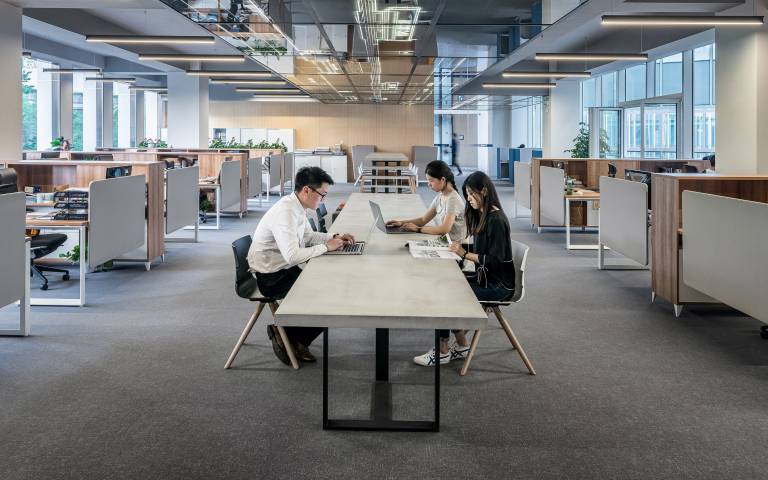Impact of noise and soundscape on cognitive performance and productivity in offices
18 May 2020
A blog by Health, Wellbeing and Sustainable Buildings MSc student Huanbin Song

People spend almost 90% of whole day in buildings1. Working in a comfortable building environment could enhance about 20% of productive performance2 and decrease 2.5% of sickness absenteeism3. Therefore, it is important for architects and designers of office buildings to know what factors in the environment most affect the status of workers and how to design a healthy and comfortable working condition.
In buildings, the states of wellbeing, comfort and health are interrelated and related to design and management4. The World Health Organization’s definition of health is ‘a state of complete physical, mental and social wellbeing and not merely the absence of disease or infirmity’5 which means a stable interaction between health and wellbeing. There are many definitions of wellbeing, but a basic understanding focuses on ‘the state of being comfortable, healthy, or happy’6. The main factors affecting occupants’ condition can be divided into three categories, including individual, building environmental, and social factors7,8. Indoor Environmental Quality (IEQ) is one of the most influential set of factors for health in the built environment, including air quality, acoustic comfort, visual comfort, and thermal comfort. Figure 1 is a conceptual diagram developed following literature review to show how IEQ factors relate to other individual and social aspects that affect health, comfort and wellbeing.

Figure 1 Conceptual model of main factors affecting occupants’ health, comfort and wellbeing in office building

Noise has been raised as a serious IEQ problem and a key factor that can be used to predict both comfort and productivity in office building9. Sources of noise in offices mainly include: outdoor noise (e.g. traffic noise), indoor mechanical noise (e.g. printer noise), and finally the greatest source affecting employee performance – indoor human activity noise (e.g. speeches and phones)10,11.
Exposure to a noisy environment for long periods can interfere with cognitive performance and affect physical and mental health (e.g. causing fatigue, irritability) which will influence workers’ productivity indirectly.
Approaches to manage noise in offices include traditional implementation of sound absorbing and soundscape design. A soundscape is ‘the acoustic environment as perceived or experienced and/or understood by a person or people, in context’12. By introducing natural sounds as the soundscape into a workspace, noise can be effectively masked13 , and psychological comfort and restorative effect can be enhanced14 . The recommended internal noise range for speech privacy in shared space, e.g. open plan office, is between 45-50dB (L Aeq,T) and for concentration required in private space, e.g. executive office, is between 35-40 dB (L Aeq,T ) 15. Research evidence indicates that it is better to investigate the specific building context and people’s expectation, and then adopt the appropriate combination of acoustical measures (mask, insulate and absorb).
However, soundscape design in office building is still in development. How to measure and collect soundscape data, how to use collected data to build predictive model, and how to manage soundscape projects with all stakeholders, are areas for further research and development in practice.
Huanbin Song is a student on the MSc Health, Wellbeing and Sustainable Buildings programme and he has a background in construction project management.
References
1 ASHRAE. Interactions Affecting the Achievement of Acceptable Indoor Environments. 2010.
2 Wheeler G, Almeida A, Clements-Croome D. Creating the Productive Workplace. 2006.
3 Leyten J, Boerstra A, editors. Comparison of productivity and absenteeism effects if indoor environmental quality in offices. Proc HB2003 Int Conf; 2003.
4 Ortiz MA, Kurvers SR, Bluyssen PM. A review of comfort, health, and energy use: Understanding daily energy use and wellbeing for the development of a new approach to study comfort. Energy and Buildings. 2017;152:323-35.
5 WHO. World Health Organization. Definition of Health 1948. Available from: https://apps.who.int/gb/bd/PDF/bd47/EN/constitution-en.pdf.
6 OXFORD. Meaning of well-being in English n.d. Available from: https://www.lexico.com/definition/well-being.
7 Bluyssen PM. Towards new methods and ways to create healthy and comfortable buildings. Building and environment. 2010;45(4):808-18.
8 Brown Z, Cole RJ. Influence of occupants' knowledge on comfort expectations and behaviour. Building Research & Information. 2009;37(3):227-45.
9 Rasheed EO, Khoshbakht M, Baird G. Does the Number of Occupants in an Office Influence Individual Perceptions of Comfort and Productivity?—New Evidence from 5000 Office Workers. Buildings. 2019;9(3):73.
10 Mak CM, Lui Y. The effect of sound on office productivity. Building Services Engineering Research and Technology. 2012;33(3):339-45.
11 Banbury SP, Berry DC. Office noise and employee concentration: Identifying causes of disruption and potential improvements. Ergonomics. 2005;48(1):25-37.
12 FDIS I. 12913-1: 2014 Acoustics—Soundscape—Part 1: Definition and Conceptual Framework. International Organization for Standardization: Geneva, Switzerland. 2014.
13 Jahncke H, Björkeholm P, Marsh JE, Odelius J, Sörqvist P. Office noise: Can headphones and masking sound attenuate distraction by background speech? Work. 2016;55(3):505-13.
14 Jahncke H, Eriksson K, Naula S. The effects of auditive and visual settings on perceived restoration likelihood. Noise & health. 2015;17(74):1.
15 BSI. BS 8233: 2014 guidance on sound insulation and noise reduction for buildings. London: BSI; 2014.
 Close
Close

